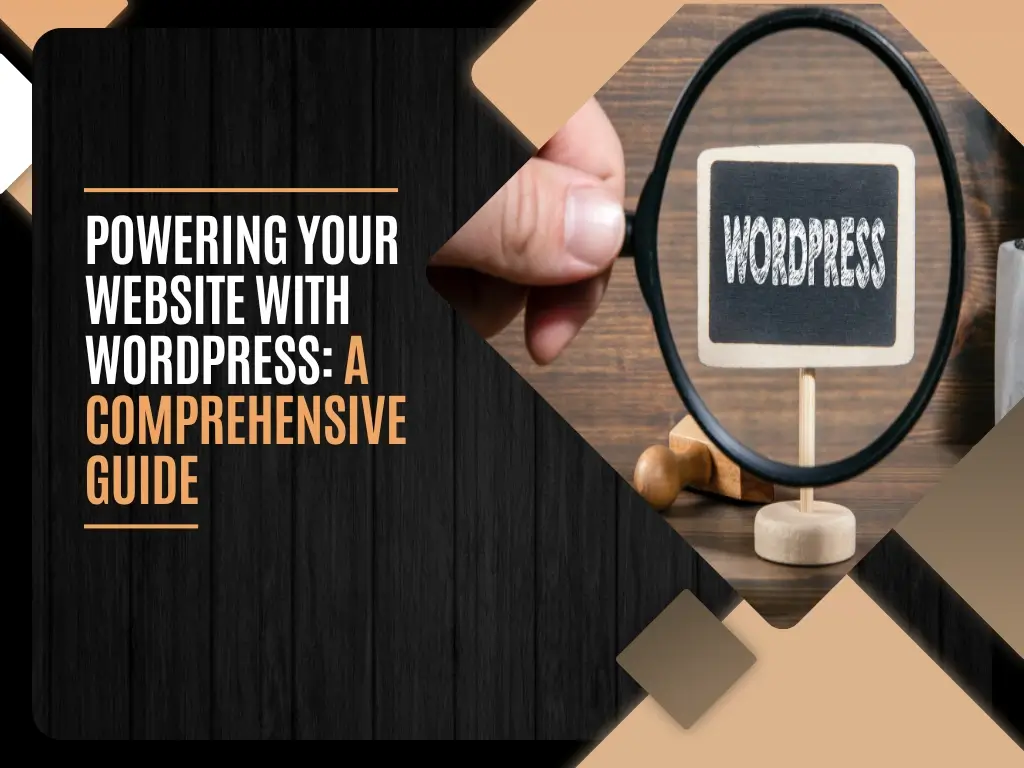Powering Your Website with WordPress: A Comprehensive Guide
Learn how to build, customize, and optimize your website with WordPress in this comprehensive guide. Perfect for beginners and experts alike.

In today’s digital landscape, having a well-designed and efficient website is crucial to your success, whether you’re a business, creative professional, or an entrepreneur. WordPress, being one of the most popular content management systems (CMS), has powered over 40% of all websites globally. But building a WordPress site is not just about putting together a few pages; the right tools can make or break your website’s functionality, aesthetics, and performance. This is where Elementor, a leading page builder for WordPress, comes into play.
In this comprehensive guide, we’ll explore why Elementor is the go-to tool for powering your website with WordPress, how it elevates your website-building experience, and why it stands as the superior choice for design and functionality.
Why Choose WordPress?
Before diving into Elementor, let’s start by discussing why WordPress is the best platform to power your website. WordPress is a versatile, open-source CMS that allows you to create anything from a simple blog to a complex eCommerce site. Its flexibility, combined with a massive library of plugins and themes, makes it an unparalleled platform for any type of website.
- Open-Source Flexibility: As an open-source platform, WordPress allows you to have complete control over your website’s code, structure, and design.
- Customizability: WordPress offers thousands of themes and plugins that allow you to customise every aspect of your site.
- SEO-Friendly: With built-in features and plugins like Yoast SEO, WordPress allows you to optimise your website to rank better on search engines.
- Community Support: With a vast community of developers and users, finding help or solutions to any issues is straightforward.
However, building a WordPress site requires more than just selecting a theme and adding content. To take full advantage of what WordPress offers, you need a page builder that gives you advanced design and customization capabilities. This is where Elementor comes into play.
The Ultimate Page Builder for WordPress
Elementor is a powerful, all-in-one drag-and-drop page builder plugin for WordPress. It allows you to design and customise your website in real-time, without needing any coding skills. Elementor is not just a page builder—it’s a complete website builder, giving you total control over every aspect of your site, from headers to footers and everything in between.
Why Elementor?
There are many page builders out there, but Elementor stands out for several reasons:
- Ease of Use: Elementor offers an intuitive, drag-and-drop interface, making it incredibly easy to use even for beginners. You can see your changes in real-time, ensuring you get the exact design you envision.
- Pre-Designed Templates: Elementor provides over 300 pre-designed templates and blocks, which you can easily customised to suit your brand’s style and needs.
- No Coding Required: You don’t need any HTML, CSS, or JavaScript knowledge to create stunning web pages. Elementor’s simple interface allows you to create complex layouts with ease.
- Advanced Design Capabilities: Elementor gives you complete control over your website’s design, from custom fonts and colours to advanced animations and transitions.
- SEO-Friendly: Elementor integrates seamlessly with SEO plugins like Yoast SEO, ensuring your website is optimised for search engines.
With Elementor, you’re not just limited to basic layouts and functionalities. Whether you want to build a portfolio, a landing page, or a full-fledged eCommerce site, Elementor has the features and flexibility you need.
Step-by-Step Guide to Powering Your Site with WordPress and Elementor
Now that you know why Elementor is the best choice for powering your WordPress site, let’s go through the steps of building a fully functional website using WordPress and Elementor.
Step 1: Install WordPress
The first step in powering your site with WordPress is, of course, installing WordPress itself. Most hosting providers offer one-click WordPress installations, making the process incredibly easy.
- Select a Hosting Provider: Choose a reliable hosting provider like Valassis Media to ensure your website’s speed, uptime, and security.
- Install WordPress: Use your hosting provider’s one-click installer or manually install WordPress by downloading it from WordPress.org.
- Choose a Domain Name: Pick a domain name that represents your brand and is easy to remember.
Step 2: Choose a WordPress Theme
Although Elementor can handle most of your design needs, choosing a theme that is compatible with Elementor will make the process smoother.
- Elementor-Compatible Themes: Popular themes like Astra, OceanWP, and GeneratePress are lightweight and work seamlessly with Elementor.
- Install and Activate Your Theme: Once you’ve chosen your theme, install it via the WordPress dashboard and activate it.
Step 3: Install and Activate Elementor
With WordPress and your theme set up, the next step is to install the Elementor plugin.
- Go to Plugins > Add New: Search for Elementor in the plugin repository and install it.
- Activate the Plugin: After installation, activate Elementor to start building your website.
Step 4: Building Your First Page with Elementor
Elementor makes it easy to build stunning web pages without writing any code.
- Create a New Page: Navigate to “Pages” in your WordPress dashboard and click “Add New.” Title your page and click “Edit with Elementor.”
- Drag-and-Drop Elements: You’ll be taken to Elementor’s drag-and-drop editor, where you can begin building your page. You can drag elements like text, images, buttons, and forms directly onto the page.
- Customise the Design: Click on each element to customise its appearance. Change fonts, colours, and layouts with just a few clicks.
Step 5: Adding Pre-Designed Templates
One of Elementor’s standout features is its extensive library of pre-designed templates.
- Choose from Over 300 Templates: Elementor offers a wide variety of templates for different types of websites, from business pages to portfolios.
- Customise to Fit Your Brand: Once you’ve selected a template, you can easily customise it to match your brand’s colours, fonts, and imagery.
Step 6: Advanced Design Features
Elementor gives you the ability to add advanced design features that take your site to the next level.
- Custom Headers and Footers: With Elementor, you can design custom headers and footers without needing any coding skills.
- Advanced Animations: Add animations to your elements to create engaging and interactive web pages.
- Mobile-Responsive Design: Elementor automatically creates a mobile-friendly version of your website, and you can further customise how your site looks on different devices.
Step 7: Optimise Your Website for SEO
A well-designed website is only effective if it can be found on search engines. Elementor works seamlessly with popular SEO plugins like Yoast SEO, ensuring your site is optimised for search.
- Add SEO Plugins: Install Yoast SEO or Rank Math to ensure your content is optimised for search engines.
- Customise Meta Titles and Descriptions: Use these plugins to customise your meta titles, descriptions, and URLs for better search engine ranking.
- Optimise Images and Loading Speed: Elementor is a lightweight plugin, but it’s always a good idea to optimise images and use a caching plugin to improve your site’s speed.
Step 8: Publish Your Website
Once you’ve finished designing and optimising your website, it’s time to publish it for the world to see.
- Preview Your Site: Before publishing, use Elementor’s preview feature to see how your site looks across different devices.
- Click Publish: When you’re satisfied with your design, click “Publish” to make your website live.
Advanced Features of Elementor
Elementor doesn’t stop at basic web design. It also offers advanced features and functionalities that allow you to create more dynamic and interactive websites. These features make Elementor a comprehensive solution for powering your WordPress site with both stunning aesthetics and robust performance.
1. Global Widgets for Consistency
Global Widgets in Elementor allow you to design an element once and reuse it across multiple pages of your site. For instance, if you have a call-to-action (CTA) button that you want to display consistently on several pages, you can create it once, save it as a Global Widget, and apply it wherever necessary.
- Time-Saving: Any changes you make to the Global Widget will automatically update across all instances, saving you time and maintaining consistency.
- Uniform Design: Ensuring that your website’s design elements are consistent not only improves the user experience but also reinforces brand identity.
2. Elementor Pro: Unlocking Full Potential
While the free version of Elementor is packed with features, Elementor Pro opens up even more possibilities for building powerful websites. Some of the most compelling features include:
- Theme Builder: This allows you to build every part of your site—headers, footers, and even WooCommerce product pages—from scratch without relying on your theme’s limitations.
- WooCommerce Builder: If you run an eCommerce store, Elementor Pro provides advanced widgets for building custom product pages, category pages, and even checkout flows.
- Popup Builder: Create stunning, conversion-focused popups using Elementor’s drag-and-drop editor. These pop ups can be used for lead generation, announcements, or promotions, all without the need for additional popup plugins.
- Form Builder: Build custom forms to collect user data, create contact forms, surveys, or even registration forms, which you can integrate with third-party services like Mailchimp, HubSpot, and others.
3. Third-Party Plugin Integration
One of the biggest advantages of Elementor is its ability to integrate with third-party plugins and tools seamlessly. This opens up endless opportunities for customization and scalability.
- Integration with Marketing Tools: Whether it’s email marketing services like Mailchimp or CRM tools like HubSpot, Elementor ensures your marketing funnel remains smooth and effective.
- Compatibility with WooCommerce: Elementor works perfectly with WooCommerce, the go-to eCommerce solution for WordPress. With Elementor, you can design custom product pages, checkout experiences, and more, giving you full control over your online store’s look and feel.
- Custom Code Integration: For developers who want to go beyond the visual editor, Elementor allows you to insert custom CSS, JavaScript, or HTML into your pages, offering limitless customization.
4. Mobile-First Design
In today’s mobile-driven world, having a responsive website is non-negotiable. Elementor not only creates mobile-responsive pages by default, but it also allows you to customise the appearance of your site specifically for mobile devices.
- Custom Breakpoints: Adjust your design to look perfect on mobile, tablet, and desktop devices by setting custom breakpoints. This allows you to tailor each version of your site for a seamless experience across all screen sizes.
- Mobile Preview: Elementor includes a mobile preview mode, allowing you to instantly see how your site will appear on mobile devices while you’re building it.
- Visibility Controls: You can even choose which elements should appear on mobile and which should be hidden. For example, you might want a particular image to be visible on desktop but hidden on mobile to speed up load times.
5. Performance Optimization with Elementor
While Elementor packs powerful features, it also ensures that your website remains fast and efficient. Here’s how Elementor helps with performance optimization:
- Lightweight Code: Elementor generates clean, optimised code, minimising the amount of CSS and JavaScript loaded on your site.
- Lazy Loading: This ensures that images are only loaded when they are needed, improving your website’s load times and performance.
- Optimization Plugins Compatibility: Elementor works seamlessly with popular optimization plugins like WP Rocket, W3 Total Cache, and others to ensure your site runs smoothly even as you add more features.
Elementor and SEO: Boosting Your Website’s Visibility
A beautifully designed website won’t achieve much if it doesn’t appear in search results. Luckily, Elementor’s integration with WordPress ensures that your site can be SEO-optimised without the need for extra steps.
1. SEO-Friendly Design
Elementor follows WordPress’s best practices for SEO, ensuring that your content is easily readable by search engines.
- Heading Tags (H1-H6): Elementor allows you to assign proper heading tags to various sections of your website, which is crucial for SEO. Using these tags correctly helps search engines understand the structure and importance of your content.
- Meta Titles and Descriptions: Integrating with SEO plugins like Yoast or Rank Math, Elementor allows you to set custom meta titles, descriptions, and slugs for each page, optimising them for search engines.
- Clean Code: Elementor’s clean, optimised code ensures that your website’s load speed is fast, a critical factor for search engine ranking.
2. Optimised for Speed
Site speed is one of the top ranking factors for SEO, and Elementor helps ensure that your WordPress site is lightning-fast.
- Built-in Lazy Loading: Elementor has lazy loading features built into its image settings, ensuring that images load only when they are in view. This reduces your site’s initial load time.
- Minified Scripts: Elementor’s lightweight architecture ensures that your site runs fast, with minified CSS and JavaScript to reduce load times.
- Caching Solutions: For even faster speeds, Elementor works seamlessly with popular WordPress caching plugins like WP Super Cache and W3 Total Cache.
3. Mobile SEO
With mobile-first indexing being a critical aspect of SEO, Elementor’s mobile-first design features ensure that your website ranks well on both desktop and mobile search results.
Real-World Use Cases: Elementor in Action
Let’s take a look at how Elementor can be applied to different types of websites and businesses, with examples to show its flexibility.
1. eCommerce Sites
For eCommerce businesses, Elementor is a game-changer. With Elementor Pro’s WooCommerce integration, you can build product pages, shop pages, and checkout pages that are fully customised to match your brand’s style. By using Elementor’s drag-and-drop features, you can create highly engaging product galleries, CTA buttons, and even animated banners, all of which help to increase conversions.
- Example: An online fashion store could use Elementor to build stunning, mobile-responsive product pages, ensuring customers have a seamless shopping experience across all devices.
2. Service-Based Businesses
Service-based websites, like consulting firms or marketing agencies, can leverage Elementor to create visually appealing landing pages, portfolio showcases, and contact forms that convert visitors into leads.
- Example: A digital marketing agency could use Elementor to build engaging case study pages, complete with interactive elements and call-to-action buttons to capture leads.
3. Creative Portfolios
For photographers, designers, and artists, Elementor provides the perfect platform to showcase their work. Its advanced image galleries, sliders, and animation effects allow creatives to present their portfolios in the best light.
- Example: A graphic designer could use Elementor’s portfolio widgets to display their work, while using hover effects and animations to add a dynamic touch.
4. Educational Websites
Educational platforms or blogs can benefit from Element’s ability to structure large amounts of content in an easy-to-navigate format. Elementor’s block layout, along with its ability to incorporate multimedia elements like video and audio, makes it an excellent choice for course creators and online educators.
- Example: A language learning blog or a coaching website could use Elementor to create visually structured lessons, complete with quizzes, videos, and interactive sections to keep learners engaged.
Conclusion: Empowering Your Site with Elementor and WordPress
When it comes to powering your site with WordPress, Elementor is undoubtedly the best tool to leverage. Its user-friendly drag-and-drop interface, combined with advanced design and functionality features, allows you to create stunning, professional websites without needing a single line of code. From its vast array of templates and widgets to its seamless third-party integrations and performance optimization features, Elementor makes website-building an effortless and rewarding experience.
For businesses like Valassis Media, which focuses on delivering B2B marketing and sales solutions to top-tier clients, including Fortune 500 companies, Elementor provides the flexibility and scalability needed to create high-performing, visually engaging websites. With Elementor, you can build a website that not only looks great but also delivers a top-tier user experience, helping to drive conversions, increase visibility, and boost your bottom line.



